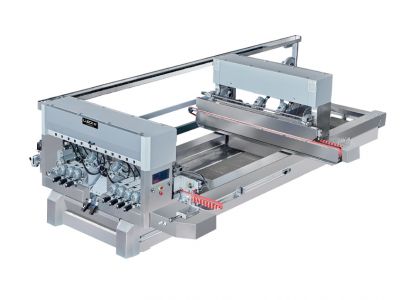INDUSTRY NEWS
The number of times the glass is edged and the grinding wheel mesh is selected!

The number of times of glass grinding and grinding wheel mesh selection is an important part of the glass processing process, directly affecting the quality and aesthetics of glass products. The following will discuss in detail the number of times the glass edge grinding process and grinding wheel mesh selection basis and its impact on the quality of glass processing:

1. The determining factors of the number of grinding
Influence of glass thickness: for different thicknesses of glass, the number of grinding times will be different. Thicker glass requires more grinding to ensure smooth edges and no chipping.
Influence of the intended use: For example, safety glass (e.g. toughened or laminated glass) may require special treatment during the grinding process in order to comply with higher safety standards.
Requirement of edge grinding quality: High quality glass products, such as those used in high-end architecture or more decorative applications, usually require more edge grinding processes to achieve better visual effects and tactile sensations.
2. Selection of grinding wheel mesh based on
Rough grinding and fine grinding needs: the grinding wheel mesh number from low to high represents the improvement of the grinding precision, the beginning is usually used low mesh (e.g. 180 mesh) for rough grinding, to remove most of the excess material, and then gradually use a high mesh wheel (e.g. 325 mesh) for fine grinding in order to obtain a smoother edge.
Glass of different materials: For example, tempered glass should not be ground with too low an abrasive wheel in order to avoid affecting the yield and the transparency of the edges.
End product usage: High precision edge grinding is not required, such as for some curtain wall projects, where a lower mesh grinding wheel may be preferred as the edge will be covered by a seal.
3. Common problems in the process of edge grinding
Generation and treatment of chipping: A common problem in the grinding process is chipping, which may be caused by too large a glass edge margin or too fast a conveying speed. Proper adjustment of these parameters can effectively reduce chipping.
Consequences of wrong choice of grinding wheel: If the grinding wheel mesh is not properly selected, it may lead to opaque or visible breaks on the edge of the glass, affecting the overall aesthetics and quality of the glass.
4. Influence of operation skills on grinding edge effect
Technician's skill: The edge grinding effect depends not only on the choice of machinery and materials, but also on the technical proficiency of the operator. Experienced technicians can better control the quality and efficiency of edge grinding.
Maintenance of equipment: Regular maintenance and calibration of the grinding equipment is also an important factor in ensuring the quality of the grinding edge, including the balance of the grinding wheels and precise mechanical adjustments.
In addition, the following information should be considered when selecting the number of times the glass should be edged and the mesh size of the grinding wheels:
Balance between material costs and process costs: While multiple edge grinding can improve product quality, it can also increase production costs. The right choice needs to be made to control costs as much as possible while maintaining quality.
Environmental and safety factors: The edge grinding process generates a lot of dust and noise, and appropriate protective measures must be taken to protect the health of the operators.
Overall, the correct selection of the number of passes and the mesh size of the grinding wheels in the glass grinding process is essential to ensure the quality of the final product. This selection process is influenced by a number of factors, including the thickness of the glass, the intended use, the precision required and the specific conditions of the operation. By taking these factors into account and using the appropriate technology and materials, the overall quality of the glass product and its competitiveness in the marketplace can be significantly improved.

